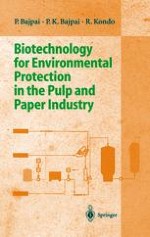1999 | OriginalPaper | Chapter
Pulp Bleaching with White Rot Fungi and Their Enzymes
Authors : Dr. Pratima Bajpai, Dr. Pramod K. Bajpai, Prof. Dr. Ryuichiro Kondo
Published in: Biotechnology for Environmental Protection in the Pulp and Paper Industry
Publisher: Springer Berlin Heidelberg
Included in: Professional Book Archive
Activate our intelligent search to find suitable subject content or patents.
Select sections of text to find matching patents with Artificial Intelligence. powered by
Select sections of text to find additional relevant content using AI-assisted search. powered by
Lignin is one of the major components in plants. Selective removal of lignin from plant cell walls has significant implications on the pulp and paper industry. Chlorine-based chemicals traditionally have been used to bleach pulps because they selectively and efficiently remove lignin. However, chlorinated organic compounds released in this bleaching process are toxic to the environment. The ever-increasing pressure from environmental protection authorities has forced the pulp and paper industry to seek an environmentally benign bleaching process. Biobleaching is one of the very promising alternatives for eliminating chlorine-based chemicals in the pulp-bleaching process. Since xylanase was found to improve the bleachability of kraft pulp,1 enormous efforts have been made to develop hemicellulase-aided bleaching. The developments in hemicellulase aided bleaching are reviewed in Chapter 4. Xylanase enzymes are now being produced for the pulp industry by several companies around the world. Many mills worldwide have experience in using xylanase prebleaching and a CPPA survey showed that as of early 1995, about 1 million tons/year or 8% of the bleached kraft pulp made in Canada was enzymetreated.5 Xylanase applications are often referred to as prebleaching or bleach boosting because the nature of the effect is to enhance the effect of bleaching chemicals rather than to remove lignin directly. The enzyme does not attack the lignin-based chromophores but rather the xylan network by which the residual lignin particles are surrounded and trapped. A limited hydrolysis of the xylan network is often sufficient to facilitate the subsequent chemical attack on lignin with various bleaching chemicals, without sacrificing yield. Mill-scale experience has demonstrated that xylanase pretreatment usually results in up-to 20-25% savings in bleaching chemicals, with simultaneous reduction of pollutant emissions.
